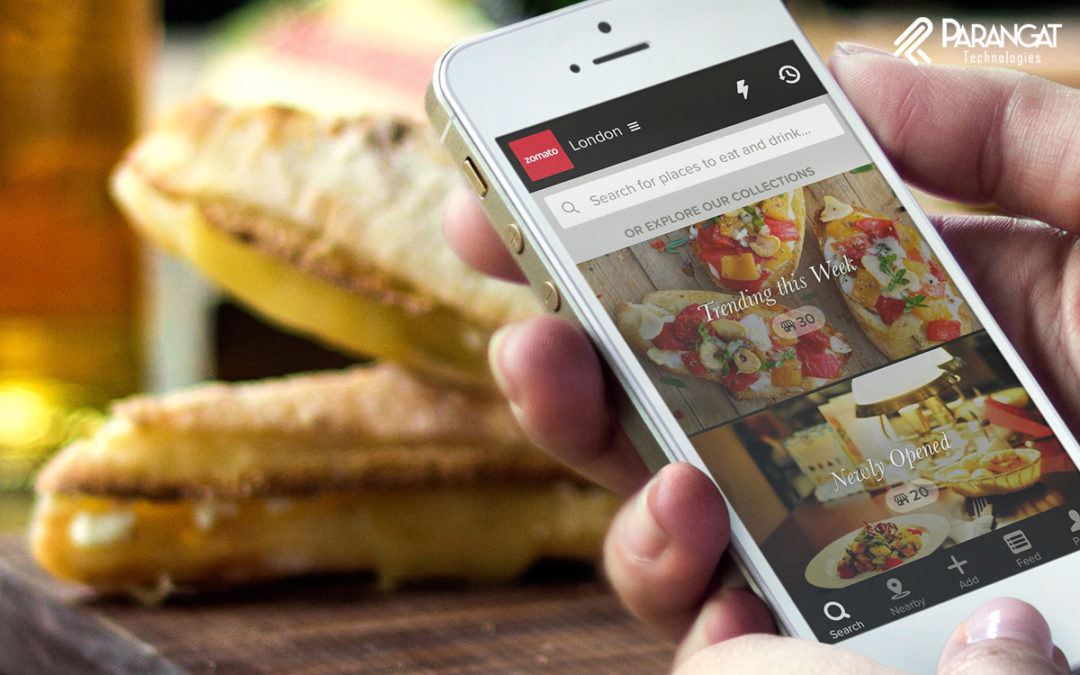Before we discuss how to make an app like Zomato, let us have a look at some stats!
The global food delivery service is going to hit the US $151 billion mark by the time the new year dings in!
And what raises eyebrows is not this figure, but the fact that it is just the \”delivery\” part of the entire food industry.
While there is no doubt that the ongoing COVID-19 pandemic contributed a lot to its growth, the entire sentiment of getting piping hot dishes right at your doorstep within minutes has an undeniably strong effect on it.
Let us understand the fact with an example – Uber Eats is the most widely available food delivery app in the world. It has a presence in 6 continents and leads the ranks in terms of gross orders across the globe.
And, Zomato acquired its Indian concern, Uber Eats India, in January 2020.
Hence, when we talk about the food delivery app ecosystem, Zomato emerges as the ideal case scenario, and this is what this post is all about!
Here, we explore how to make an app like Zomato and dissect its interface, business model, and other important features.
So, dive in, and learn what it all takes to make an app like Zomato.
Why Is a Food Delivery App Important?
The online food delivery market valuation was US $4.35 billion in 2020 and is set to grow with a CAGR of 30.1% from 2021 to 2026. Availability of the high-speed internet, increase in the sale of mobile phones, and a growing working population is fuelling the numbers even more.
Further, the major industry players, like Domino’s, McDonald’s and Zomato, etc., have introduced contactless deliveries. The food delivery apps are getting all the points in their favor combined with the entire work-from-home scenario and inflating incomes in India.
So, if you plan to join the ecosystem and get a piece of this pie, get ready with a plate!
“NOW” is the best time to make an entry on the scene.
Below, we discuss how a food delivery app like Zomato can help you.
1. Brand Building/ Awareness
India is currently the second-largest market across the globe for app downloads since 2021. Every day its citizens are spending 4.8 hours using mobile apps, and the food delivery apps are one of them.
Over the years, app usage is increasing, and having an app is just like creating a more direct and capable channel of communication and service for your customers. With people spending almost 5 hours daily on apps, creating a food delivery app like Zomato is one sure shot way to spread brand awareness.
Having a mobile app allows you to cater to a wider range of customers and gain more prospects as well.
2. Most Appropriate Medium to Drive Sales
Aesthetics, emotional marketing, sentiment targeting, and extremely personalized services – the food delivery apps offer you a huge arsenal of functionalities to rev your sales. Unlike a paper-based restaurant menu that doesn’t show the images and lacks the appeal to the foodie sentiment, a food delivery app similar to Zomato has everything.
You can send app users offers and personalized discounts on weekends and festive days to \”nudge” them. Apps also allow you to show curated content such as visuals and ads to a specific segment and serve highly-targeted content built around events.
You can have app wallets to store loyalty points and also offer out-of-the-box functionalities, such as live tracking, etc.
All these things provide a positive thrust to your sales and amount to higher revenue.
3. Retargeting the Existing Customers
Online food delivery apps target the sentiments of your customers. They show the visuals, ads, and offers other appealing content along with the enticing deals and offers. So, even casual browsing can result in an order, no matter how small or large it is.
Thus, the apps keep your customers engaged.
Fully-engaged customers have a 23% higher share in boosting revenue, relationship growth, and profitability. And, when you are in the online food delivery industry, you might want your customers to engage with your brand at least once a day, or even more than that.
Even if every app interaction doesn\’t result in a purchase, it keeps the customer in the loop with the latest offers and anything new you have to offer, such as:
- Combo offers
- Events or giveaways
- New vendors or sellers, you have got listed
So, as soon as the customer feels like placing an order, they can make the right decision with a proper understanding of the best offer available.
Hence, the apps facilitate effortless retargeting of existing customers.
4. More Prospects and Leads
Apps don’t require special link-clicking or any other login. So, people have a higher tendency to download them, even if they use them rarely. But, once they have an app on their device, the day they want to eat something special (which is frequent), they just have to open the app, and BAM!
This is what makes online food delivery apps like Zomato so great!
Hence, having a dedicated online food delivery app widens your horizons and helps you reach the masses in an easier way.
Take a look at how average revenue per user by segment is more in the case of \”platform to consumer” as shown below:
5. Specific and Targeted Marketing Campaign
Running a campaign for an individual customer is a next to impossible task because of the obvious effort and time involved. But, having an app allows you to personalized marketing and campaigning to a granular level.
This ability stems from the customer app data that gets collected over time. Leveraging data analytics to curate and serve highly tailored user experiences allows you to target your customers with a firm understanding of their expectations.
This is why the “platform to consumer” delivery revenue is on a consistent rise against the “restaurant to consumer” revenue in India, as shown in the following visual:
Thus, you are able to drive more results from every campaign and pump your revenue streams.
Finally, India stands 3rd in the list of top 5 countries across the globe in the revenue generated by the online food delivery segment, right after China and the US.
After discussing the importance of having an online food delivery app, let us move one step ahead.
Next, we share the business model of Zomato to figure out how to make an app similar to Zomato.
Business Model of Zomato App
The Zomato App has the classic “on-demand” business model, a visual representation of which is shown below:
Zomato App has three main offerings:
- Online food delivery order functionality
- Online table booking
- Zomato Gold – Premium membership for special offers and benefits in dine-in places
In the business model, there are three core entities:
1. User
The user selects from the given options of restaurants, selects the order items, quantity, etc. They can also interact with the app to book a table or to share the unique registration number to avail the special Zomato Gold benefits.
2. Admin
Once the order is punched in, a notification goes to the admin, the selected restaurateur, and the nearest delivery person. The key point is, there are no dedicated delivery services or dedicated chain of restaurants of Zomato. All three entities coordinate with each other to make the delivery happen.
3. Delivery guy
The delivery guy coordinates with the restaurateur and delivers the food to the user.
So, there are three key app stakeholders in a clone of the Zomato app source code:
- Admin Module
- User Module
- Delivery Module
Now that we have created a skeleton of a food delivery app like Zomato, we move on to share the must-have features.
Important Features for an App Like Zomato
1. Admin Module
The admin module caters to the admin or the brand owner, like Zomato. The admin must be able to monitor and track the deliveries, delivery team, etc. They also require analytics and a specific admin dashboard to manage the owner-side of the business.
The core functionalities in this module are:
- Live Tracking and Monitoring
The owners can track and monitor the delivery persons and the entire delivery fleet across the entire network. The functionality and coding involved would escalate as the business scales.
- App Analytics
The app analytics will cater to the different number-based and analytics-based business requirements. Some common examples include the number of orders, segmentation of orders, areas, customers, and various analytical operations for all of them. The number of restaurants, delivery persons, and analytical operations for them – the admin will be able to see all types of numbers and trends and get well-formed reports if required.
- Admin Dashboard
The admin dashboard will offer various functionalities related to the business side of the app. Some examples include route management, driver and delivery stats, restaurant profiles and marketing section, campaign, etc.
2. User Module
The user module will focus on the user-side of the business, and it will comprise the UI, functionalities, and controls that you want your user to see. The customer-specific app recommendations and purchases, offers, restaurant profiling, and favorites – are all going to be there.
This module will also show the various account details, order history, app permissions, payment gateways, search box, etc.
Some core functionalities in this module are:
- Search Option
The user can search the restaurants, cities, food items, etc., via this option. The results are displayed on the screen, and the user can select one of their choices.
- Call the Delivery Person and Restaurant
The user might also want to call the restaurant and delivery person regarding the deliveries, order confirmation, late deliveries, etc. So, this is also a must-have feature.
- Social Media Integration
While users might find it hard to register themselves on the app, they are more than ready to use their social media accounts for using the app. They can alter the app permissions and preferences anytime from the UI.
- Different Modes of Payment
Your app must offer multiple modes of payment for the order, such as cash, cards, mobile banking, and UPI platforms.
- Alerts and Notifications
Alerts and notifications can be sent via messages, in-app notifications, and emails. They can be about multiple scenarios, such as order status, delivery rating, restaurant rating, rating the experience or app, and getting the latest offers in the inbox.
- Real-Time Order Tracking
The user must have the real-time animation of their order on their digital devices. This keeps the user engaged with the app for the time the order is out for delivery. It also keeps the levels of anticipation high while beating the waiting blues at the same time.
- Rewards/Coupons
This section holds the various coupons or rewards details for a user. Premium benefits details are also present here.
3. Delivery Module
This module will focus on the delivery side of the business model. The contact details, navigation functionality and trip monitoring and logs are some of the must-have functionalities. This module will cater to all the stakeholders – user, admin, and delivery persons.
- Navigation
Navigation is required to show the real-time tracking of orders and offer restaurant information from a particular area. Other location-related functionalities also use the navigation
- Contact Details of Restaurateur and Delivery Team
The users might want to call the delivery person and restaurant for various purposes, and this functionality is another must-have.
- Trip Logs and Details
Admin checks the trip logs and details to validate the deliveries and count the work hours or to calculate performance in relation to various KPIs of the delivery team.
- Route Optimization Module
This module helps the delivery person to choose the best possible route for delivery
- Start/End Trip
The delivery persons use this module to enter the trip start and end details in the app. This keeps the normal or personal traveling via the vehicle separate from the order-related work.
Some other important functionalities for a clone of the Zomato app include:
- Customer care
- Order histories
- Transaction histories
- Loyalty Points or tokens
- Review features
- Map Views
- Photo sharing
- User profile
- Login and Signup
- Surveys
How Much Does It Cost to Make an App Like Zomato?
If you wish to know how much it costs to make an app like Zomato, you must understand that there are different costs involved. Apart from the developer effort involved, there are certificates, compliances, payment gateway integration, etc., that come as added costs to the entire setup.
Below, we discuss the various types of costs involved in the process to offer you an overall idea of the costing:
1. App Platform
As shown in the visual above, the average cost (per hour) of mobile app development in India is US $30 for Android apps, US $26 for iOS apps, and US $21 for Windows apps.
2. App Developer
This cost varies from person to person and case to case. The expert professionals will obviously be costlier than the novices, and there are many developers that offer designing and content services as well. So, the cost will vary from one developer to another.
Also, the cost might vary from one development stage to another.
However, to give you an idea, we have shared a visual below:
3. App Design
Now, apart from the platform, you have to pay for the app design. Remember that the overall design must be clean, organized, and user-oriented. It must show all the options in an easy-to-understand manner to allow the users to place orders without any hassle.
Neat design with no confusion is one of the core strengths of the Zomato app.
The designing costs vary from app to app, depending on the type of effort involved.
4. App Size
Now, this is the trickier part; the more functionalities you include in the app, the costlier it gets. Now, if you want to make an application like Zomato, you have to add a lot of engaging features and versatile functionalities, such as table reservation, delivery, ratings, etc.
The more features you add, the app size increases, and the costlier the app becomes!
Key Tips to Follow While Making an App Like Zomato
In order to make an app like Zomato, there are some key considerations mentioned below:
- Provide customers with easy navigation
- User-friendly UI
- Frequently updating the data regarding dishes, venues, restaurants etc
- Multiple payment gateways option along with high security and safety
- Refer to friend/ relatives section
- 24*7 customer support service
- Rating and review section
- Clean and organized user dashboard
- Easy-to-manage user profile
The Three Es of How to Make an App Like Zomato: Ease, Expertise and Experience
With the online food industry booming across the globe and Zomato making the IPO buzz, the segment is under a major app development hype.
While everybody is in the race to get the \”Zomato clone\” for a similar or different segment, there are three things you must always keep in mind:
- Ease – The app must be easy to use, manage, and understand.
- Expertise – Opt for the right app development company, such as Parangat.com that offers excellent app development services and mobility solutions that scale well with your business. Experience – Until or unless you have used, processed, and understood the actual Zomato app, you are not able to make the best decisions regarding the UI and functionalities.
- Experience – Until or unless you have used, processed, and understood the actual Zomato app, you are not able to make the best decisions regarding the UI and functionalities.
Finally, always finalize the design and functionalities, keeping your business type, scale, and expert opinion in mind.
Remember that adding functions as you scale will help you curb the initial development investment and keep your app aligned to the market and customer sentiment.

With roll up sleeves, dive in and get the job done approach, it was in the year 2010 when Sahil started Parangat Technologies. Emphasizing a healthy work culture and technology-driven company, he has successfully created a workplace where people love to work and live. He is a software engineer and a passionate blockchain enthusiast.


 +44-7511-112566
+44-7511-112566 +353-1-8079571
+353-1-8079571 +1-415-799-9792
+1-415-799-9792

